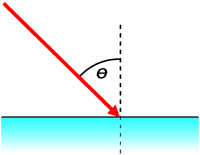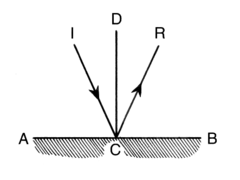Angle of Incidence - Key Pointers, Definition, Formula, FAQs
Key Pointers
The following are some crucial points to help you grasp the notion of angle of incidence.
1. The incident ray is the light ray that strikes the polished surface.
2. The reflected ray is the ray that is reflected away.
3. The point of incidence is the location where light strikes a surface.
4. The normal is a line that is drawn perpendicular to that location.
JEE Main/NEET 2027: Physics Important Formulas for Class 10
NEET 2025: Mock Test Series | Syllabus | High Scoring Topics | PYQs
JEE Main: Study Materials | High Scoring Topics | Preparation Guide
JEE Main: Syllabus | Sample Papers | Mock Tests | PYQs
- Key Pointers
- What is Angle of Incidence?
- What is Incidence Ray?
- What is Angle of Reflection? Define Angle of Reflection
- What is Angle of Emergence?
- What is Angle of Refraction?
- The angle of refraction is the angle formed by the refracted beam and the normal at the point of incident.
- Relation between Angle of Incidence and Angle of Refraction
What is Angle of Incidence?
Angle of Incidence Meaning: The angle of incidence is defined in physics as the angle created by a ray propagating on a surface and the line normal to the point of occurrence on the same surface.

To comprehend the angle of incidence, we must first explore the notion of light reflection in depth. This article will provide you with detailed information on the angle of incidence as well as several key concepts linked to the subject.
Here are some crucial aspects to remember when it comes to incidence angle:
The incident ray is the ray that strikes the mirror's smooth surface initially.
The reflected ray is one that travels away from the incident ray's point of origin.
The point of incidence is the point at which a beam of light travels.
A perpendicular line drawn from the same point is known as a normal.
Also read -
- NCERT Solutions for Class 11 Physics
- NCERT Solutions for Class 12 Physics
- NCERT Solutions for All Subjects
What is Incidence Ray?
A light ray that strikes a surface is called an incident ray. The ray that depicts the light reflected by the surface is the reflected ray that corresponds to a specific incident ray. The angle of reflection is the angle formed by the surface normal and the reflected beam.
Angle of Incidence Formula-
Because of the rule of reflection, the angle of incidence equals the reflected angle. The angle of incidence and reflection are always the same, and they are both in the same plane as the normal.
What is Point of Incidence?
The point of incidence will be where the beam of incidence hits the mirror. Now let's have a look at the normal parameter. The normal is a line that intersects the mirror surface at a right angle. Normally, this line is drawn at the point of incidence.

Related Topics Link, |
What is Angle of Reflection? Define Angle of Reflection

The angle between the approaching wave's direction of motion and a perpendicular to the reflecting surface (angle of incidence) is equal to the angle between the reflected wave's direction of motion and a perpendicular to the reflecting surface (angle of reflection).
NCERT Physics Notes :
What is Angle of Emergence?
The angle of emergence refers to the angle at which light emerges from a medium (such as a glass slab with parallel sides). The ray of light travels through the air at an angle and enters the glass. As light enters the glass, it refracts or bends, then continues on and emerges at a different angle back into the air.
What is Angle of Refraction?
The angle of refraction is the angle formed by the refracted beam and the normal at the point of incident.

Also read,
- NCERT solutions for Class 12 Physics Chapter 9 Ray Optics and Optical Instruments
- NCERT notes Class 12 Physics Chapter 9 Ray Optics and Optical Instruments
- NCERT Exemplar Class 12 Physics Solutions Chapter 9 Ray Optics and Optical Instruments
Relation between Angle of Incidence and Angle of Refraction
- The refraction of light occurs when the path of light goes through one medium and into another, according to scientists. The incident ray, refracted ray, normal (perpendicular to the point of incident), and point of incidence are all factors in the refraction process.
- The ray of light makes contact with two different materials. The first name refers to a more scarce medium, whereas the second refers to a denser medium.
- When compared to the speed of light in the denser medium, the rarer medium has a faster speed.
- The medium has a significant influence on the angle of incidence and refraction.
- Air or any other type of gas is an example of a rarer medium. Denser media include glass, diamonds, and kerosene. The speed of light is slowed inside the denser medium, but there is no resistance to the speed of light from any rarer media.
Did you know?
1. We use the degree unit to measure both the angle of incidence and the angle of refraction.
2. At the point of impact, all rays, including refracted and incident rays, are on the same interface as the normal.
Also check-
Frequently Asked Questions (FAQs)
When the angle of incidence equals the critical angle in total internal reflection, the angle of reflection is 90°.
Because the light ray chooses the shortest path to its destination, the angle of incidence equals the angle of reflection. Fermat's principle describes how light behaves. When a light ray is reflected from a plane surface, it exhibits the same behaviour. As a result, the incidence and reflection angles are the same.
The ray of light strikes a plane mirror normally, which implies the angle of incidence is 0° rather than 90°. As a result, the reflection angle is 0°.
When the angle between the incident ray and the mirror is increased, the angle of reflection decreases. Because of the glancing angle of incidence, this is the case. The angle created by the incident ray and the mirror is known as the glancing angle of incidence. In addition, the angle of incidence and the glancing angle of incidence add up to 90 degrees. As a result, as the glancing angle increases, the incidence angle decreases. Angle of incidence equals angle of reflection, as we all know. As a result, the angle of reflection is reduced.
The stated assertion is correct. In other words, the principles of reflection apply to all sorts of mirrors.
Also Read
05 Feb'25 04:41 PM
30 Nov'24 01:19 PM
29 Nov'24 05:26 PM
29 Nov'24 02:40 PM
29 Nov'24 01:21 PM
28 Nov'24 04:42 PM
28 Nov'24 01:26 PM
28 Nov'24 01:21 PM
26 Nov'24 03:50 PM
22 Nov'24 01:31 PM

